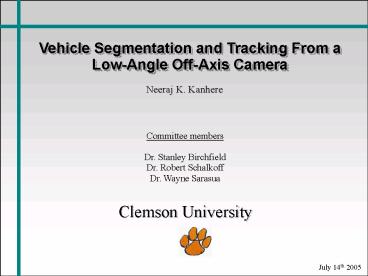Vehicle Segmentation and Tracking From a LowAngle OffAxis Camera - PowerPoint PPT Presentation
Title:
Vehicle Segmentation and Tracking From a LowAngle OffAxis Camera
Description:
Estimate coordinates with respect to each stable feature. Select the coordinates minimizing weighted sum of Euclidean distance and trajectory error ... – PowerPoint PPT presentation
Number of Views:56
Avg rating:3.0/5.0
Title: Vehicle Segmentation and Tracking From a LowAngle OffAxis Camera
1
Vehicle Segmentation and Tracking From a
Low-Angle Off-Axis Camera
Neeraj K. Kanhere
Committee members Dr. Stanley Birchfield Dr.
Robert Schalkoff Dr. Wayne Sarasua
Clemson University
July 14th 2005
2
Vehicle Tracking
Why detect and track vehicles ?
- Intelligent Transportation Systems (ITS)
- Data collection for transportation engineering
applications - Because it's a challanging problem!
Loop detectors
Tracking using Vision
- Low per unit cost
- Field experience
- No traffic disruption
- Wide area detection
- Rich in information
- No tracking
- Maintenance difficult
- Computationally demanding
- Expensive
3
Available Commercial Systems
- AUTOSCOPE (Image Sensing Systems)
- Has been around for more than a decade
- Dedicated Hardware
- Reliable operation
- Good accuracy with favorable camera placement
- VANTAGE (Iteris)
- New in market
- Accuracy has been found to be lower than
Autoscope
4
Related Research
- Region/Contour Based
- Computationally efficient
- Good results when vehicles are well separated
- 3D Model Based
- Large number of models needed for different
vehicle types - Limited experimental results
- Markov Random Field
- Good results on low angle sequences
- Accuracy drops by 50 when sequence is processed
in true order
- Feature Tracking Based
- Handles partial occlusions
- Good accuracy for free flowing as well as
congested traffic conditions
5
Factors To be Considered
High angle
Low angle
- More depth variation
- Occlusions
- A difficult problem
- Planar motion assumption
- Well-separated vehicles
- Relatively easy
6
Overview of the Approach
Offline Calibration
Background model
Frame-Block 1
Feature Tracking
Estimation of 3-D Location
Frame-Block 2
Frame-Block 3
Grouping
Counts, Speeds and Classification
Block Correspondence and Post Processing
7
Processing a Frame-Block
Overlap
Block n
Block n1
- Multiple frames are needed for motion information
- Tradeoff between number of features and amount of
motion - Typically 5-15 frames yield good results
features in block
frames in block
8
Background Model
Time Domain Median filtering
- For each pixel, values observed over time
- Median value among observations
- Simple and effective for the sequences considered
- Adaptive algorithm required for long term modeling
9
Frame Differencing
- Partially occluded vehicles appear as single blob
- Effectively segments well-separated vehicles
- Goal is to get filled connected components
10
Offline Calibration
Control points
- Required for estimation of world coordinates
- Provides geometric information about the scene
- Involves estimating 11 unknown parameters
- Needs atleast six world-image correspondances
11
Calibration Process
- Using scene features to estimate correspondences
- Standard lane width (e.g. 12 feet on an
Interstate) - Vehicle class dimensions (truck length of 70
feet) - Relies on human judgment and prone to errors
- Approximate calibration is good enough
12
Estimation using Single Frame
- Box-model for vehicles
- Road projection using foreground mask
- Works for orthogonal surfaces
camera
vehicle
Road plane
13
Selecting Stable Features
- Shadows, partial occlusions will result into
wrong estimates - Planar motion assumption is violated more for
features higher up - Select stable features, which are closer to road
- Use stable features to re-estimate world
coordinates of other features
14
Estimation Using Motion
- Estimate coordinates with respect to each stable
feature - Choose coordinates which minimized weighted sum
of euclidean distance and trajectory error
- Rigid body under translation
- Estimate coordinates with respect to each stable
feature - Select the coordinates minimizing weighted sum of
Euclidean distance and trajectory error
- Coordinates of P are unknown
- Coordinates of Q are known
- R and H denote backprojections
- 0 first frame of the block
- t last frame of the block
- ? Translation of corresponding point
15
Affinity Matrix
- Each element represents the similarity between
corresponding features - Three quantities contribute to the affinity
matrix - Euclidean distance (AD), Trajectory Error (AE)
and Background- Content (AB)
- Normalized Cut is used for segmentation
- Number of Cuts is not known
16
Incremental Cuts
- We apply normalized cut to initial A with
increasing number of cuts - For each successive cut, segmented groups are
analyzed till valid groups are found - Valid Group meeting dimensional criteria
- Elements corresponding to valid groups are
removed from A and process repeated starting from
single cut
Avoids specifying a threshold for the number of
cuts
17
Correspondence Over Blocks
- Formulated as a problem of finding maximum wieght
graph - Nodes represent segmented groups
- Edge weights represent number features common
over two blocks
an groups in block N bn groups in block N1
18
Results
19
Results
20
Conclusion
- A novel approach based on feature point tracking
- Key part of the technique is estimation of 3-D
world coordinates - Results demonstrate the ability to correctly
segment vehicles under severe partial occlusions
Future Work
- Handling shadows explicitly
- Improving processing speed
- Robust block-correspondance
21
Questions ?
22
Thank You !































